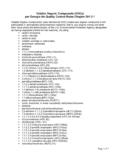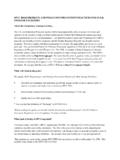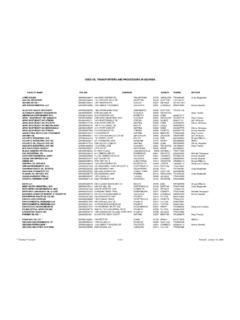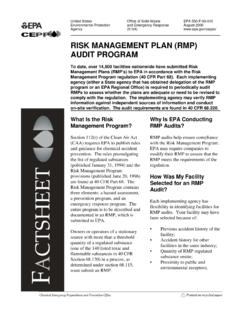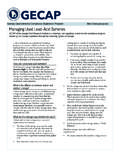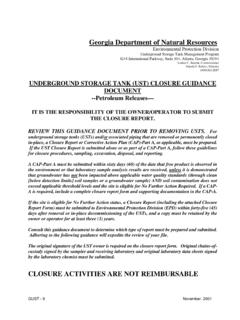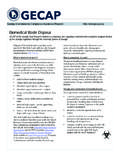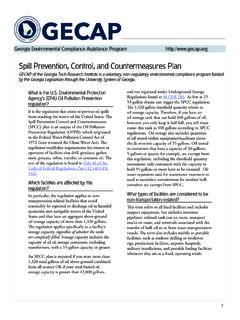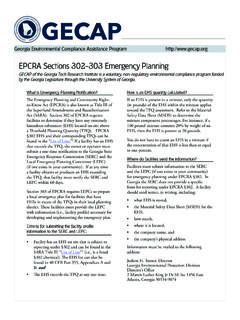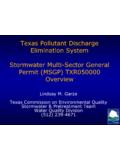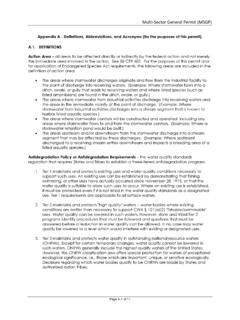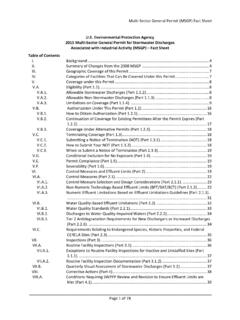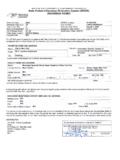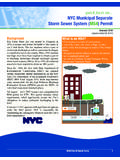Transcription of Fact Sheet NPDES Permit - GECAP | Georgia …
1 1 State of Georgia Department of Natural Resources Environmental Protection Division fact Sheet National Pollutant Discharge Elimination System ( NPDES ) General Permit No. GAR050000 Storm Water Discharges Associated with Industrial Activity January 17, 2012 Introduction This fact Sheet describes the basis and procedures for reissuance of Georgia s 2006 NPDES General Storm Water Permit (GAR000000) as the proposed 2012 NPDES General Storm Water Permit (GAR050000) for discharges of storm water associated with industrial activity. This Permit is referred to as the 2012 IGP. The current Permit (2006 IGP) expired July 31, 2011; however, the 2006 IGP continues in force and effect (Part VII. B) until the proposed Permit becomes effective. An NPDES Permit was first issued for industrial storm water in Georgia in 1993; it was reissued in 1998. In 2003, the 1998 Permit expired and was administratively extended. A draft Permit was issued for public comment in 2004, which was subsequently revised and reissued in 2005.
2 The 2005 Permit was appealed. The 2006 IGP was issued August 1, 2006, incorporating the results of two settlement agreements. Permit Basis The 2012 IGP authorizes all new and existing storm water point sources within Georgia to discharge storm water associated with industrial activity, excluding construction, to the waters of the State upon submittal of a Notice of Intent (NOI). The 2012 IGP is in compliance with, and is based upon, the provisions of the Georgia Water Quality Control Act ( Georgia Laws 1964, p. 416, as amended, State Act ), the Federal Clean Water Act, as amended (33 et seq., Clean Water Act ), and the Rules and Regulations promulgated subsequent to each of these Acts. The proposed Permit is patterned after the Environmental Protection Agency (EPA) Multi-Sector General NPDES Permit (2008 MSGP) for industrial storm water issued September 29, 2008. The 2008 MSGP is available at: ; and the EPA fact Sheet for the 2008 MSGP is available at: The 2012 IGP is reformatted and renumbered from previous permits.
3 The numbering system is very similar to the 2008 MSGP. Parts 1 through 7 and Appendices A, B and D contain information pertinent to all permittees. Part 8 contains the sector specific requirements; typically one, or at most a few, of the sectors in Part 8 will apply to any one permittee. Appendix C contains information for those permittees who discharge to impaired stream segments. Appendix E addresses hardness testing for facilities with the hardness dependent benchmark values cadmium, copper, lead, nickel and zinc. 2 The 2012 IGP benchmark values and recommended procedures, practices, control measures and best management practices (BMPs) are based principally on the 2008 MSGP. Activities Covered by the Permit The following table is the list of categories of industrial facilities that are required to obtain NPDES Permit coverage for storm water discharges as identified in 40 CFR Part (b)(14)(i) through (ix) and (xi): Sector A: Timber Products Sector O: Steam Electric Generating Facilities Sector B: Paper and Allied Products Sector P: Land Transportation and Warehousing Sector C: Chemical and Allied Products Manufacturing Sector Q: Water Transportation: Maintenance/Cleaning Sector D: Asphalt Paving and Roofing Materials and Lubricant Manufacturing Sector R: Ship and Boat Building and Repairing Yards Sector E: Glass, Clay, Cement, Concrete, and Gypsum Products Sector S: Air Transportation Facilities Sector F: Primary Metals Sector T: Treatment Works Sector G: Transportation Equipment, Industrial or Commercial Machinery Sector U: Food and Kindred Products Sector H.
4 Electronic, Electrical, Photographic, and Optical Goods Sector V: Textile Mills, Apparel, and Other Fabric Products; Leather and Leather Products Sector I: Oil and Gas Extraction Sector W: Furniture and Fixtures Sector J: Mining and Dressing Sector X: Printing and Publishing Sector K: Hazardous Waste Treatment, Storage, or Disposal Facilities Sector Y: Rubber, Miscellaneous Plastic Products, and Miscellaneous Manufacturing Industries Sector L: Landfills, Land Application Sites, and Open Dumps Sector Z: Leather Tanning and Finishing Sector M: Automobile Salvage Yards Sector AA: Fabricated Metal Products Sector N: Scrap Recycling Facilities Sector AB: Non-Classified Facilities A more specific and detailed listing of facilities required to obtain coverage under the 2012 IGP is contained in Appendix D of the Permit , which includes the SIC Codes associated with the facilities shown in the table above. In addition to the facilities classified as requiring coverage under the 2012 IGP by SIC Code, EPD may designate a particular facility to obtain coverage under the 2012 IGP, even though the facility does not meet the definition of a category of activities generally required to be covered by the Permit .
5 This corresponds with Sector AB. Such a designation would be made by the Director of EPD where there is a concern for the discharge to cause a water quality problem. Maintaining Coverage under the 2012 IGP Current permittees are required to submit a new Notice of Intent (NOI) to obtain coverage under the 2012 IGP and to maintain coverage for discharging storm water associated with industrial 3 activities. Facilities previously covered under GAR000000 will have up to 30 days to submit the new NOI for coverage under GAR050000 after the effective date. If a facility failed the benchmark sampling required by Part of the 2006 Permit , then the facility may not be authorized to discharge storm water under the proposed Permit and may be required to apply for an individual NPDES Permit or alternative general Permit . The facility has the options to conduct 12 months of flow-weighted composite sampling to demonstrate the discharge does not cause or contribute to an exceedance of water quality standards (Appendix ) or make the necessary improvements to the facility to achieve the instream water quality standard as an effluent limit within 36 months (Appendix ).
6 Subsector U3 facilities that failed the benchmark sampling required by Part of the 2006 Permit using a TSS benchmark have the option to conduct fecal coliform testing for 12 months to confirm their ability to cause or contribute to an exceedance of the fecal coliform Water Quality Standard, or prevent all exposure to storm water from animal handling areas and/or capture and treat storm events of inches within animal handling areas within 36 months (Appendix and c). Existing facilities which filed under the No Exposure Exclusion (NEE) of the 2006 IGP must submit a new NEE form no later than 30 days after the effective date of the 2012 IGP (Part ) to retain NEE status. New Facilities Seeking Coverage under the 2012 IGP New dischargers commencing discharge on or after the effective date of the 2012 IGP must submit an NOI for coverage 7 days prior to commencing discharge. Major Changes in the 2012 IGP Major changes in the 2012 IGP from the 2006 IGP include: 1.
7 The 2012 IGP is organized like EPA s 2008 MSGP: a. The first third of the Permit contains general Permit information, applicable to all industrial sectors (Parts 1 through 7). b. The second third covers the requirements for each industrial sector (Part 8). c. The last third is reference material such as abbreviations and standard Permit conditions, included as appendices. The appendices also include Impaired Stream Segment Sampling, a table stating what activities are covered by the Permit , and the hardness calculation table/guidance (Appendices A, B, C, D and E). 2. There were 21 sectors required to conduct annual analytical sampling in the 2006 IGP (Part ). The 2012 IGP has 27 specific industrial sectors (Part 8); however, not every sector requires annual analytical sampling. 3. Each sector may have additional suggested best management practices specific to that industry (Part 8). Sector-specific requirements are based on the types of pollutants expected to be present in storm water discharges as a result of industrial activity at facilities listed in the sector.
8 4. The 2012 IGP benchmarks are a combination of benchmarks from the 2006 IGP and the MSGP. However, just like the 2006 IGP, the 2012 IGP benchmark values are not considered effluent limits and exceeding a benchmark is not a Permit violation. 5. The 2006 IGP did not provide target values for many benchmarks, which created a problem for permittees and regulators that had to be resolved on a case-by-case basis. 4 This problem has been resolved in the 2012 IGP with target values provided for almost all benchmarks. 6. The 2012 IGP also allows for facilities to establish their own benchmarks through the use of published studies by qualified personnel that establish the industry standard, site-specific studies by professional engineers, or basin area ratios used in conjunction with the site-specific instream Georgia Water Quality Standards or EPA s Water Quality Criteria. 7. The Numeric Effluent limitations section (Part V) has increased from 6 types of discharges to 7 (Part and Table 1-1).
9 Phosphate fertilizer manufacturing storm water limits were added per 40 CFR 418, Subpart A. 8. The 2012 IGP requires all analytical sampling performed during the term of the previous Permit , to be summarized and the summary retained until the end of the next Permit term (Part ), whereas the 2006 IGP did not. 9. The 2006 IGP requires all records pertaining to that Permit be kept one year after coverage of the Permit is terminated (Part ) except sampling and analytical testing information, which was required to be kept for three years after the sampling date (Part ). The 2012 IGP requires all records pertaining to the Permit to be kept for three years after coverage of the Permit is terminated (Part ). 10. The requirement to conduct routine facility inspections on a quarterly basis and annual benchmark monitoring does not apply at a facility that is inactive and unstaffed (Parts and ). The 2012 IGP clarifies procedures that were decided on a case-by-case basis under the 2006 IGP.
10 11. At least once during the term of the 2012 IGP, a dye, smoke, or equivalent test must be conducted to evaluate for the presence of non-storm water discharges into the storm sewer system, where applicable (Part ). The 2006 IGP did not have this requirement. Equivalent test methods include TV surveillance and analysis of as-built drawings and schematics. 12. If there is an exceedance of a benchmark value, under the 2012 IGP the facility is required to make modifications of best management practices (BMPs) and sample each subsequent quarter until the benchmark is met (Part ) or make a determination that no further pollutant reductions are technologically available and economically practicable (Part ). There was no requirement for follow-up sampling in the 2006 IGP. 13. The 2006 IGP did not specify laboratory accreditation. In the 2012 IGP, all monitoring data not prepared in situ is required to be prepared by a laboratory registered or accredited by the State of Georgia or, where the permittee does their own analysis with their own personnel, by a Laboratory Analyst certified in compliance with the Georgia State Board of Examiners for Certification of Water and Wastewater Treatment Plant Operators and Laboratory Analysts Act (Part ).
